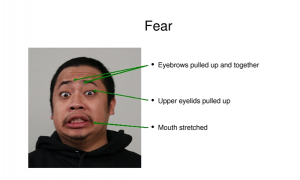 “The only thing we have to fear is Fear itself”, Franklin D. Roosevelt (inaugural speech, 1933).
“The only thing we have to fear is Fear itself”, Franklin D. Roosevelt (inaugural speech, 1933).
Fear can be a motivator or a crippling disease that keeps one from trying something new or difficult. Most of us can explain the emotion of fear, can recognize the facial expression of fear and can recount a time when they have personally experienced fear.
But how does fear really work?
Most of us have at one time or another experienced, what society has linguistically termed, fear. But biologically speaking how does fear make us act the way it does? According to io9.com: neuroscience , science knows how our brains process fear, but all the neural underpinnings of fear still remain a mystery.
Fear is one of the seven scientifically proven universal facial expressions of emotion. The universal trigger of fear is a threat to one’s well-being. The brain processes fear with the amygdala, almond-shaped clusters of neurons deep in our medial temporal lobes.
It has long been believed that the amygdala played a role in processing fear, how big a role had been undetermined until now. A 1939 study revealed that removing the temporal lobes entirely (this includes the amygdala and connective fiber tissues within the lobes) made primates more tame, less aggressive and less responsive to fearful situations.
In another study in 1952, it was discovered that taking out only the amygdalae had the same effect of the disappearance of fear. However, there has not been any revealing evidence of the effect of such a procedure on a human.
The ever increasing advancements in technology have allowed science to delve deep into the brain and focus on particular regions without causing collateral damage to adjoining regions of the brain. In their review, “Neuropsychology of Fear and Loathing”, published in the journal Nature neuroscentists Andrew Calder, Andrew Lawrence and Andrew Young made observations about the the scientific strides in understanding the processing power of the amygdala and fear in the human brain. They attribute advancements such as the fMRI for the ability to safely probe deeper into certain portions of the brain without damaging other portions.
The most popular human case study has shown that there is quite a difference between perceiving fear and having the ability to experience fear via brain signals (i.e. fight or flight response). It was recently published, in January of 2011, and conducted on a human with Urbach-Wiethe disease (renders her amygdala useless). The study revealed that the amygdala is a pivotal area in the brain for triggering (experiencing) fear.
What are your thoughts on fear?
Some people like to experience mild fear (just look at Halloween thrill seekers) and some people can’t stand the idea of being frightened, even if it is only a fleeting emotion.
What would you do if you couldn’t experience fear? Would that be a bad thing or would that perhaps be beneficial?
Without being able to experience fear you may not be able to accurately assess danger. During my thrill-seeking 20’s, I did things like parachuting and repelling, but I did so with an air of caution (mostly).
However, I cannot stand to be startled and I abhore scary movies like Halloween. Consistently experiencing fear in movies and real life can lead to desensitizing one to certain fears, which can be harmful in my opinion.
But it is also true that fear can be crippling when it comes to real life experiences with loved ones and situations from the past. In this case, take that amygdala away NOW! ;o|
DiLady,
Your comment that consistently experiencing fear can lead to desensitization is very insightful. This is true of many emotions, we can see this in many cases of abused people who become desensitized to the abuse they received and in turn perpetuate the behavior without realizing the effects or being numb to them (i.e. child abuse is one example parents who were abused abusing their kids).